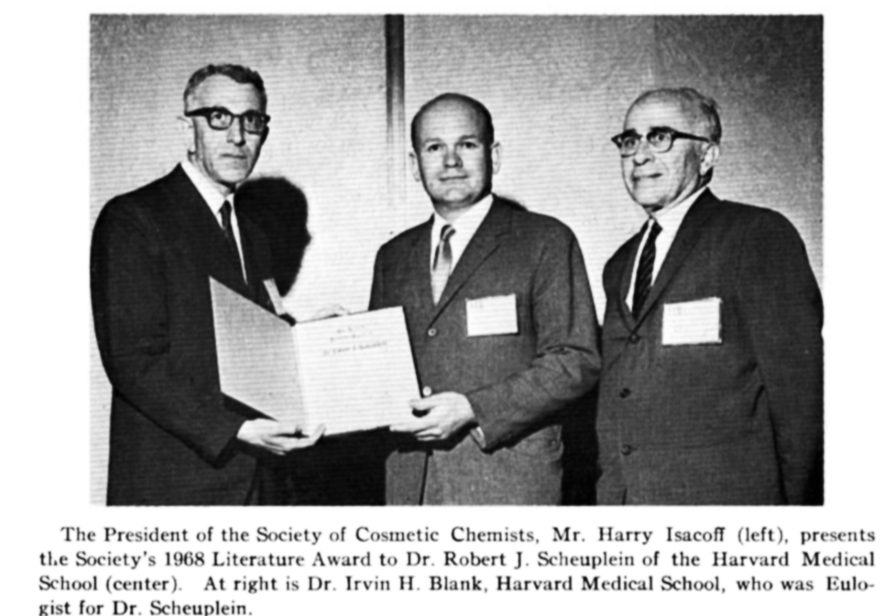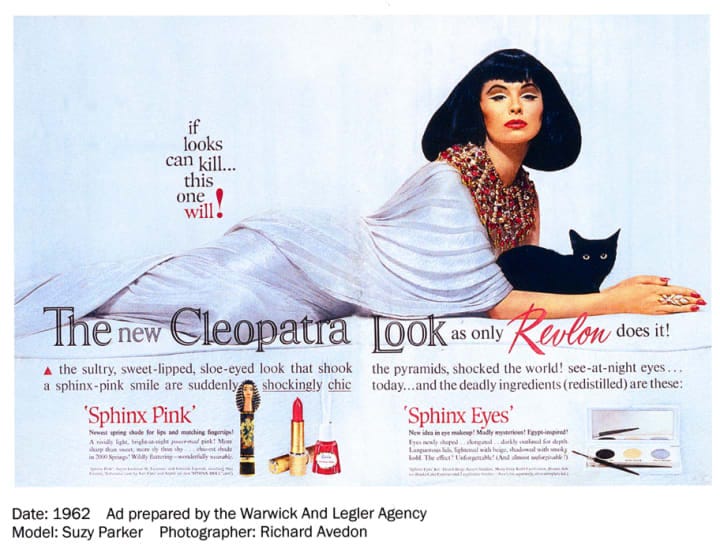Cosmetic Chemistry and Its Problem with Women Scientists
Makeup R&D is a male-dominated field??
The faces of cosmetic chemistry in 1968. Cosmetic chemistry research was male-dominated.
The mainstream beauty industry has largely lacked inclusivity in its product development and marketing. However, as problematic as its marketing is, cosmetic companies seem like spaces where women chemists could flourish. Typically barred from many industry and government jobs, historically women scientists sought to apply their skills in “feminine” areas, such as cooking and cleaning. Furthermore, many of these major cosmetic companies started with female leaders. Cosmetic development is sometimes even used to pique girls’ interest in STEM.
However, most major cosmetic companies have NOT prioritized hiring women scientists in Research & Development. Many have not had women in key leadership or corporate positions. Today, 48.1% of cosmetic chemists in the United States are women and only 10% are Black. Historically, cosmetic chemists, and hence product formulation, have been developed by white men.
Cosmetic Chemistry: The Beginnings
The science behind cosmetic development is called “cosmetic chemistry”. Cosmetic chemistry requires a rigorous scientific background and a minimum of a bachelor’s degree in chemistry. Cosmetic chemistry not only develops female-orientated beauty products (lipsticks, eyeshadow), but other items like shampoos, antiperspirants, toothpaste, and sunscreen which are used by broader markets. Yearly revenue from the sales of such products in the U.S. exceeds $200 billion.
Pioneers in the beauty industry include Madame C.J. Walker (Madam C. J. Walker Manufacturing Company), Helena Rubinstein, Mary Kay (Mary Kay Inc), Elizabeth Arden (Elizabeth Arden, Inc.), and Estée Lauder (Estée Lauder Companies). Of these leaders, only Madame C.J. Walker actually developed her own products and focused on promoting and training women scientists in her company. For example, she developed shampoos and ointments to heal scalp infections from infrequent hair washing, during a time when indoor plumbing was not common.
Madame C.J. Walker and her products.
Other female leaders in the beauty industry merely marketed and promoted their products (developed by men) and sometimes promoted pseudoscience around skincare, especially Helena Rubinstein. They often overpriced products and perfected the “the makeover”. There was a general lack of scientific rigor in the development of these cosmetics resulting in products that irritated the skin, rather than heal it.
Of course, many beauty companies were also founded by men. Notably, L’Oreal was founded by a man who developed a new hair dye (Eugène Paul Louis Schueller). Ulta Beauty was founded by Richard E. George and Terry Hanson. e.l.f. (EyesLipsFace) cosmetics was founded by Joseph Shamah and Scott-Vincent Borba in June 2004, with the assistance of Shamah's father.
By the 1940s, “cosmetic chemistry” was formalized into a legitimate field of scientific study. The Society of Cosmetic Chemists (SCC) was founded in 1945 in New York City to “establish a medium through which scientific knowledge of the toilet goods industry can be disseminated, and to improve cosmetic and perfumery chemists' professional standing. Its purpose shall be limited to such as are scientific, professional, educational or charitable."
However, none of the founding members of the SCC were women. The first female leader of SCC came 16 years after the organization's founding. It was not until 1956 that the chemist Florence Emeline Wall was one of the first women to receive the medal of the Society of Cosmetic Chemists. The SCC also produced the The Journal of Cosmetic Science which publishes original research articles related to cosmetic chemistry. Perusing through several issues, many of these authors were male:
Number of research articles in The Journal of Cosmetic Science with all men as authors, all women as authors, and a mix of male and female authors. I randomly selected 2 journals from each decade and determined how many research articles were authored by men and women. If authors used initials for a first name, then it was marked as “unclear”.
The number of women in cosmetic chemistry would have been well below 50%, even without employer discrimination, given the low number of women majoring in chemistry. Doctorate obtainment for U.S. women in chemistry was well under 50% for the entire 20th century. Bachelor obtainment for U.S. women in chemistry did not hit 50% until the 2010s. Between the years 1950-1962 in the United States:
There were approximately 10,000 chemistry doctorates awarded
Women earned about 5% of PhDs in chemistry per year
Women earned about 19% of bachelor’s degrees in chemistry per year (the minimum qualifications for a job in cosmetic chemistry)
Women earned about 20% of master’s degrees in chemistry per year
However, it was almost impossible for women chemists to actually obtain jobs industrial labs. As far back as the 1935, Florence Wall even wrote an “advice” article for women interested in cosmetic chemistry called “TRAINING in CHEMISTRY for the COSMETIC INDUSTRY”. In 1964, 122 female chemistry doctorates were surveyed and all but 3 had careers in chemistry, indicating a strong interest in working. (“A very large majority of both the single, long-term career women and those who followed the dual pattern reported a high degree of satisfaction. Some said there was still too much downgrading of women chemists “because they were women”.) However, the ones with children wished for more part-time options, which industry was very reluctant to provide. (“Part-time employment opportunities are very important in the women’s accommodation of both career and marriage. For this group almost all such opportunities were found in academic institutions. Private industry and government offered almost none.”) These women worked almost exclusively in academia doing part-time teaching or research. There were certainly trained and interested women who wanted to work in industry; industry refused to accommodate.
LEFT: % of women PhDs by field from 1965-2000 (chemistry circled in red). RIGHT: Breakdown of women earning bachelor's degrees in chemistry 2014-2024.
Women in the beauty industry were mainly employed as saleswomen. There seemed to be little efforts to recruit women scientists in most large companies. For example, a “Helen Ryan” who worked at unspecified role in Revlon visited female students at Cornell University in 1946 to give makeup tutorials rather than to talk of job opportunities.
Madame C.J. Walker’s company seemed to be the sole exception to training and hiring women scientists to create the product. Her company also had an in-house lab for cosmetic research. Walker had direct control over the development of her company and hired several thousand women as sales agents, since most department stores refused to stock her products. Walker also had a female corporate staff including Freeman Ransom, Robert Lee Brokenburr, Alice Kelly, and Marjorie Joyner,
Unfortunately, after Walker’s death in 1919, the company struggled financially and closed in 1981. The company’s building remained as the “Madam Walker Legacy Center”. Recently, a line of Madame CJ Walker Products has been revived and sold.
The Normalization of Cosmetics
By the 1950s, the beauty industry and cosmetic sales were taking off (80-90% of American women wore lipstick). Since the 1920s, cosmetic applications were marketed as a sign of “empowerment” for the “modern woman”. Intense marketing was used to normalize cosmetic application within the American women’s daily routine. (Notably, mainstream cosmetic options ignored the needs of women with darker skin-tones and worked to enshrine racist ideals of beauty.)
An infamous Revlon ad advertising the “Cleopatra” look, which involved heavy eye makeup. With an ad like that do you think they were going to take women chemists seriously?
With increased disposable income by a booming middle-class, fashion was catered towards the “masses” rather than elite wealthy women. Beauty companies and fashion magazines began promoting the “ideals of beauty”. Such beauty was signaled to be a pre-requisite for male approval leading to the “ultimate happiness”— marriage. However, these marketing and scientific decisions were largely male-dominated. These scientists even admitted that many cosmetic products irritated the skin, rather than promoting healing. Harmful ingredients still permeate personal care products.
I have more to write about the current status of cosmetic chemists in the beauty industry today, stay tuned!








